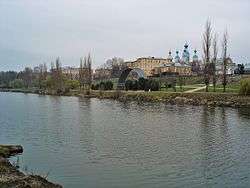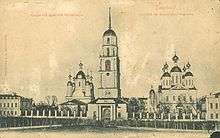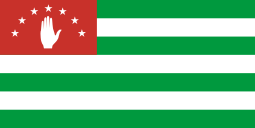Tambov
| Tambov (English) Тамбов (Russian) | |
|---|---|
| - City[1] - | |
 The Tsna River in Tambov | |
.svg.png) Location of Tambov Oblast in Russia | |
 Tambov | |
|
| |
.svg.png) |
|
|
| |
| City Day | June 12 |
| Administrative status (as of November 2011) | |
| Country | Russia |
| Federal subject | Tambov Oblast[1] |
| Administratively subordinated to | city of oblast significance of Tambov[1] |
| Administrative center of | Tambov Oblast,[1] Tambovsky District,[1] city of oblast significance of Tambov[1] |
| Municipal status (as of November 2011) | |
| Urban okrug | Tambov Urban Okrug[2] |
| Administrative center of | Tambov Urban Okrug,[2] Tambovsky Municipal District[2] |
| Mayor | Yury Rogachev |
| Statistics | |
| Area | 90.89 km2 (35.09 sq mi)[3][4] |
| Population (2010 Census) | 280,161 inhabitants[5] |
| - Rank in 2010 | 65th |
| Density | 3,082/km2 (7,980/sq mi)[6] |
| Time zone | MSK (UTC+03:00)[7] |
| Founded | April 17, 1636 |
| City status since | 1719 |
| Postal code(s)[8] | 392000 |
| Dialing code(s) | +7 4752 |
|
| |
| Tambov on Wikimedia Commons | |

Tambov (Russian: Тамбов; IPA: [tɐmˈbof]) is a city and the administrative center of Tambov Oblast, Russia, located at the confluence of the Tsna and Studenets Rivers, about 480 kilometers (300 mi) south-southeast of Moscow. Population: 280,161 (2010 Census);[5] 293,658 (2002 Census);[9] 304,600 (1989 Census).[10]
Etymology
The name "Tambov" originates from the Moksha language word "томба" (tomba) meaning "abyss".[11][12]
History
Tambov was founded by the decree of Tsar Mikhail Fyodorovich on April 17, 1636 (Old Style). Originally, it was a border fortress against attacks by the Crimean Tatars, but it soon declined in importance as a military outpost. It then became the region's administrative and trade center.
Roman Boborykin, the emperor's court menial (stolnik) and voivode was the town's first builder. Thanks to his experience, the fortress had been completed rapidly. Tambov was granted city status in 1719.
In 1779, Tambov Viceroyalty was formed, and on August 16, 1781, Empress Catherine the Great approved the city's coat of arms depicting a beehive, symbolizing the town's hardworking residents. This viceyorality was formed from southern parts of Ryazan Viceyorality and northern parts of Voronezh Viceyorality. In March 1786, the disgraced Russian poet and statesman Gavrila Derzhavin was appointed the governor of Tambov Governorate—a post that he held until December 1788. Even during that brief tenure he accomplished a great deal: a theater, a college, a dancing school, a printing business, an orchestra, and a brickyard were built. Tambov later erected a monument to Derzhavin.
In November 1830, during the Cholera Riots in Russia, the citizens of Tambov attacked their governor, but they were soon suppressed by the regular army. Later in the 19th century Tambov became a significant cultural center that supported a growing number of schools, libraries, and other institutions. By 1897, its population was more than 50,000 people.
During the Civil War, in 1920–1921, the region witnessed the Tambov Rebellion—a bitter struggle between local residents and the Bolshevik Red Army. In 1921, a Tambov Republic was established, but it was soon crushed by the Red Army under the command of Mikhail Tukhachevsky. Between 1928 and 1934, Tambov became okrug center in Central Black Earth Oblast. After dissolving the oblast on 13 June 1934, it became the raion center in Voronezh Oblast.Tambov finally became center of Tambov Oblast, which was created from oblasts of Voronezh and Kuybyshev on 27 September 1937. The oblast had present form after separation of Penza Oblast (formerly part of Kuybyshev one) on 4 February 1939.
During and after World War II, most of the Malgré-nous from Alsace-Moselle were jailed in "Camp #188" at Tambov. Between 4,000 and 10,000 French people died in this camp.[13] In 1991, a 360-meter (1,180 ft) high guyed television antenna was built in Tambov.
Administrative and municipal status
Tambov serves as the administrative center of the oblast and, within the framework of administrative divisions, it also serves as the administrative center of Tambovsky District, even though it is not a part of it.[1] As an administrative division, it is incorporated as the city of oblast significance of Tambov—an administrative unit with the status equal to that of the districts.[1] As a municipal division, the city of oblast significance of Tambov is incorporated as Tambov Urban Okrug.[2]
Economy
The city is highly industrialized.
Transportation
The city is a large industrial center and is served by Tambov Donskoye Airport. Tambov is also the location of the Tambov air base of the Russian Air Force. A railway connection between Tambov and Moscow was first established in 1871.[14] The railroad goes on to Saratov. The tracks at Tambov's station do not have electrification. There are passenger train routes from Tambov to other such cities as Volgograd, Sochi, St. Petersburg, Voronezh, and some cities along the Trans-Siberian Railroad. There are also small suburban trains, or "rail buses" that connect Tambov Oblast's capital with other cities, such as Michurinsk, Uvarovo, and Kirsanov.
Climate
Tambov has a humid continental climate (Köppen climate classification Dfb tend to Dfa). The average temperature of the coldest month (February) is about -8 °C, the warmest month (July) – about +20 °C. Because of the southerly location average annual temperature in Tambov is about 2 degrees higher than in Moscow. Annual rainfall ranges from 400 to 650 mm, more than half of them (about 270 mm) of precipitation falls in the warm season. Duration of the warm period is 154 days.
| Climate data for Tambov | |||||||||||||
|---|---|---|---|---|---|---|---|---|---|---|---|---|---|
| Month | Jan | Feb | Mar | Apr | May | Jun | Jul | Aug | Sep | Oct | Nov | Dec | Year |
| Record high °C (°F) | 6.6 (43.9) |
8.5 (47.3) |
17.6 (63.7) |
29.7 (85.5) |
36.1 (97) |
38.8 (101.8) |
41.1 (106) |
41.0 (105.8) |
35.2 (95.4) |
26.5 (79.7) |
14.6 (58.3) |
11.8 (53.2) |
41.1 (106) |
| Average high °C (°F) | −4.5 (23.9) |
−4.3 (24.3) |
1.6 (34.9) |
13.2 (55.8) |
20.9 (69.6) |
24.4 (75.9) |
26.5 (79.7) |
25.0 (77) |
18.5 (65.3) |
10.2 (50.4) |
1.2 (34.2) |
−3.5 (25.7) |
10.8 (51.4) |
| Daily mean °C (°F) | −7.5 (18.5) |
−7.9 (17.8) |
−2.4 (27.7) |
7.5 (45.5) |
14.5 (58.1) |
18.4 (65.1) |
20.4 (68.7) |
18.7 (65.7) |
12.7 (54.9) |
6.1 (43) |
−1.4 (29.5) |
−6.3 (20.7) |
6.1 (43) |
| Average low °C (°F) | −10.5 (13.1) |
−11 (12) |
−5.8 (21.6) |
2.7 (36.9) |
8.7 (47.7) |
12.9 (55.2) |
14.9 (58.8) |
13.2 (55.8) |
8.2 (46.8) |
2.8 (37) |
−3.7 (25.3) |
−9.1 (15.6) |
1.9 (35.4) |
| Record low °C (°F) | −38 (−36) |
−36.9 (−34.4) |
−30.4 (−22.7) |
−15.3 (4.5) |
−4 (25) |
0.4 (32.7) |
4.4 (39.9) |
2.5 (36.5) |
−3.7 (25.3) |
−14.7 (5.5) |
−29.3 (−20.7) |
−36.1 (−33) |
−38 (−36) |
| Average precipitation mm (inches) | 37 (1.46) |
31 (1.22) |
27 (1.06) |
26 (1.02) |
42 (1.65) |
72 (2.83) |
54 (2.13) |
44 (1.73) |
53 (2.09) |
46 (1.81) |
45 (1.77) |
41 (1.61) |
518 (20.39) |
| Source: Pogoda.ru.net[15] | |||||||||||||
Culture
The city is home to two universities, Tambov State University and Tambov State Technical University. The Tambov Art Gallery houses a vast collection of canvases by Russian and West-European artists. Russia's oldest drama theater is located in Tambov, as well as two universities, two military colleges, a musical school, a museum of local lore, and other cultural institutions.
Sports
Tambov's professional association football team, FC Spartak Tambov, plays in the Russian Second Division.
Notable people
- Andrey Kolmogorov (1903–87), mathematician
- Sergei Rachmaninoff, musician
- Alexander Lodygin, electrical engineer
- Nikolay Fyodorov, religious philosopher
- Lev Kuleshov, movie director
- Ida Kar, photographer
- Victor Merzhanov, pianist
- Anastasia Rodionova, tennis player
- Arina Rodionova, tennis player
- Yuri Zhirkov, football player
Twin towns and sister cities

Tambov is a sister city of:
 Balchik, Bulgaria
Balchik, Bulgaria Bar-le-Duc, France
Bar-le-Duc, France Grodno, Belarus
Grodno, Belarus Sukhumi, Abkhazia
Sukhumi, Abkhazia Terre Haute, Indiana, United States
Terre Haute, Indiana, United States
References
Notes
- 1 2 3 4 5 6 7 8 Law #72-Z
- 1 2 3 4 Law #232-Z
- ↑ Росстат. База данных показателей муниципальных образований
- ↑ Доклад «О состоянии и использовании земель в Тамбовской области в 2011 году» Приложение 1. Распределение земель Тамбовской области по категориям в разрезе районов и городов (на 1 января 2012 года, га)), стр. 108. Данные на 1 января 2012 года.
- 1 2 Russian Federal State Statistics Service (2011). "Всероссийская перепись населения 2010 года. Том 1" [2010 All-Russian Population Census, vol. 1]. Всероссийская перепись населения 2010 года (2010 All-Russia Population Census) (in Russian). Federal State Statistics Service. Retrieved June 29, 2012.
- ↑ The value of density was calculated automatically by dividing the 2010 Census population by the area specified in the infobox. Please note that this value may not be accurate as the area specified in the infobox does not necessarily correspond to the area of the entity proper or is reported for the same year as the population.
- ↑ Правительство Российской Федерации. Федеральный закон №107-ФЗ от 3 июня 2011 г. «Об исчислении времени», в ред. Федерального закона №271-ФЗ от 03 июля 2016 г. «О внесении изменений в Федеральный закон "Об исчислении времени"». Вступил в силу по истечении шестидесяти дней после дня официального опубликования (6 августа 2011 г.). Опубликован: "Российская газета", №120, 6 июня 2011 г. (Government of the Russian Federation. Federal Law #107-FZ of June 31, 2011 On Calculating Time, as amended by the Federal Law #271-FZ of July 03, 2016 On Amending Federal Law "On Calculating Time". Effective as of after sixty days following the day of the official publication.).
- ↑ Почта России. Информационно-вычислительный центр ОАСУ РПО. (Russian Post). Поиск объектов почтовой связи (Postal Objects Search) (Russian)
- ↑ Russian Federal State Statistics Service (May 21, 2004). "Численность населения России, субъектов Российской Федерации в составе федеральных округов, районов, городских поселений, сельских населённых пунктов – районных центров и сельских населённых пунктов с населением 3 тысячи и более человек" [Population of Russia, Its Federal Districts, Federal Subjects, Districts, Urban Localities, Rural Localities—Administrative Centers, and Rural Localities with Population of Over 3,000] (XLS). Всероссийская перепись населения 2002 года [All-Russia Population Census of 2002] (in Russian). Retrieved August 9, 2014.
- ↑ Demoscope Weekly (1989). "Всесоюзная перепись населения 1989 г. Численность наличного населения союзных и автономных республик, автономных областей и округов, краёв, областей, районов, городских поселений и сёл-райцентров" [All Union Population Census of 1989: Present Population of Union and Autonomous Republics, Autonomous Oblasts and Okrugs, Krais, Oblasts, Districts, Urban Settlements, and Villages Serving as District Administrative Centers]. Всесоюзная перепись населения 1989 года [All-Union Population Census of 1989] (in Russian). Институт демографии Национального исследовательского университета: Высшая школа экономики [Institute of Demography at the National Research University: Higher School of Economics]. Retrieved August 9, 2014.
- ↑
- ↑ Мокшанско-русский словарь / НИИЯЛИЭ при Совете Министров Правительстве Республики Мордовия; Под редакцией Б. А. Серебрянникова, А. П. Феоктистова, О. Е. Полякова - Москва: Русский язык: Дигора, 1998.
- ↑
- ↑ Train Station in Tambov (Russian)
- ↑ "Pogoda.ru.net" (in Russian). Retrieved September 8, 2007.
Sources
- Тамбовская областная Дума. Закон №72-З от 21 июня 1996 г. «Об административно-территориальном устройстве Тамбовской области», в ред. Закона №544-З от 11 июня 2015 г. «О внесении изменений в статью 7 Закона Тамбовской области "Об административно-территориальном устройстве Тамбовской области"». Опубликован: "Тамбовская жизнь", №131, 1996 г. (Tambov Oblast Duma. Law #72-Z of June 21, 1996 On the Administrative-Territorial Structure of Tambov Oblast, as amended by the Law #544-Z of June 11, 2015 On Amending Article 7 of the Law of Tambov Oblast "On the Administrative-Territorial Structure of Tambov Oblast". ).
- Тамбовская областная Дума. Закон №232-З от 17 сентября 2004 г. «Об установлении границ и определении места нахождения представительных органов муниципальных образований в Тамбовской области», в ред. Закона №606-З от 7 декабря 2015 г. «О внесении изменений в Закон Тамбовской области "Об установлении границ и определении места нахождения представительных органов муниципальных образований в Тамбовской области"». Вступил в силу со дня официального опубликования. Опубликован: "Тамбовская жизнь", №185 (23125). (Tambov Oblast Duma. Law #232-Z of September 17, 2004 On Establishing the Borders and Determining the Location of the Representative Organs of the Municipal Formations of Tambov Oblast, as amended by the Law #606-Z of December 7, 2015 On Amending the Law of Tambov Oblast "On Establishing the Borders and Determining the Location of the Representative Organs of the Municipal Formations of Tambov Oblast". Effective as of the official publication date.).
External links
- Official website of Tambov (Russian)
- Pictures of Tambov
- Tambov news (Russian)
 Chisholm, Hugh, ed. (1911). "Tambov (town)". Encyclopædia Britannica (11th ed.). Cambridge University Press.
Chisholm, Hugh, ed. (1911). "Tambov (town)". Encyclopædia Britannica (11th ed.). Cambridge University Press.- Tambov Rebellion by Sennikov Published by Posev, in Moscow 2004. ISBN 5-85824-152-2